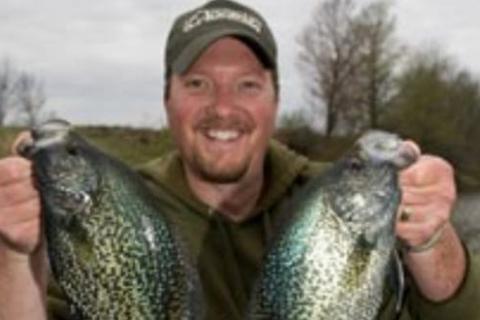
Spring's a productive time to fish crappie as these panfish stack-up on predictable spots and are often willing biters. Immediately following ice-out you'll find crappie in and around protected, shallow water. These zones are teeming with forage, and crappie will feed heartily for several weeks until the water's warm enough for spawning, which occurs between late spring and early summer. Cracking the code on early-season crappie relies on the golden rule of real-estate: location, location, location. And when talking papermouths in spring, this means fishing the Three Cs: coves, creeks and canals.
The Fishing Action is in the Sheltered, Shallows
 Protected, sun-drenched, shallow-water areas that fit the Three Cs (Coves, Creeks, Canals) are the VIP lounges of the spring papermouth party. They're comfortable, bustling with activity, and well-stocked with hors-d'oeuvres. This is because they're the first areas to warm after ice-out. Spots on a northern side of a water system can be particularly good as they receive the most sunshine and are protected from cold, north winds.
Protected, sun-drenched, shallow-water areas that fit the Three Cs (Coves, Creeks, Canals) are the VIP lounges of the spring papermouth party. They're comfortable, bustling with activity, and well-stocked with hors-d'oeuvres. This is because they're the first areas to warm after ice-out. Spots on a northern side of a water system can be particularly good as they receive the most sunshine and are protected from cold, north winds.
To go a step further, look for soft, dark-bottom areas. Like solar panels, these zones absorb the sun's energy. Dirty water and decaying plant materials can have a similar heat-soaking affect. Don't get put off by the muddy appearance — this is ground-zero for the feeding festivities.
Crappie Facts: The Highs and Lows of Crappie Fishing (infographic)

 The abundant sunlight that coves, creeks and canals receive increases their water temperature and stimulates the food chain. Plants grow and give off oxygen. Aquatic insects also get rambunctious as fly hatches loom in the near future. In turn, the boom in food and warmer water attracts baitfish. Crappie follow, moving shallow to chow-down on invertebrates and minnows.
The abundant sunlight that coves, creeks and canals receive increases their water temperature and stimulates the food chain. Plants grow and give off oxygen. Aquatic insects also get rambunctious as fly hatches loom in the near future. In turn, the boom in food and warmer water attracts baitfish. Crappie follow, moving shallow to chow-down on invertebrates and minnows.
The Three Cs all provide a cornucopia of crappie edibles, and when combined with the right habitat they're prime early-season spots.
Tip: The Rookie's Guide to Spider Rigging for Crappie
1. Fishing in Coves for Crappie
I think of coves in a nautical sense when it comes to spring crappie. These are sanctuaries hidden from winds and open water. On blustery days these inlets are relatively tranquil. Not all coves are created equal though when it comes to alluring crappie.
Bullrushes and reeds boost a cove's property value. The winter's snow and ice will have pushed over a lot of their stalks, and the result's prime cover for crappie and a multitude of insects and minnows. Add some sunken or standing wood and the area's even better. Healthy weeds are always good to find in coves. They attract crappies and their forage alike.

prime spot for finding early
spring crappie.
Some coves feature an inflowing creek. The warm meltwaters and the various foodstuff creeks carry appeal to panfish. Finding these two components together often means you've located a prime fishing spot.
2. Fishing in Creeks for Crappie
Still to slow-moving creek arms are other great spring-time spots. Fallen or submerged, standing trees are crappie magnets. Look for timber that's outside of a creek's main flow. There also tends to be a lot of debris floating in creeks during spring. Expect branches and other pieces of cover that collect this refuse to hold fish.
Undercuts are another hotspot. Add some wood cover and you've hit pay-dirt. The shelter and space of these two combined elements appeals to crappie. Bullrush-lined inlets and pockets are also good bets on creeks.
A word of warning: Rain and subsequent increased water flow can temporarily set back fishing quality. Once the system stabilizes, creeks will crank out catches again.
3. Fishing in Canals for Crappie
Several different types of canals are paradise for crappie in spring. One type is constructed to expand waterfront property and create sheltered docking space for land owners. Another is a trench created for agriculture irrigation. Bullrushes, stumps, healthy weeds and old dock pilings will all hold fish in these dug-outs.
Another type of canal is designed to connect lakes and feature locks. These robust structures attract crappie in spring, before the gateways begin their open-water operation.
The stone walls of these structures serve double duty: They block wind but also absorb the sun and radiate its heat. Regardless of style, the best canals have little or no flow, helping them quickly warm-up and retain their temperate water.
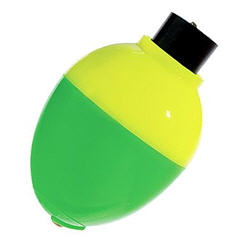
Tip: The Cold Weather Fishing Drop-Back Dance: Nothing inspires "they were here the other day" syndrome better than cold weather in early spring.
While calm, sunny days encourage crappie to move shallow, weather fronts do the opposite and push fish out. The good news is they rarely go far. Look for fish near habitat features like a weed edge, a standing tree in deep water, or a drop off.Fool Crappie with Fishing Floats and Bobbers
While an assortment of tactics will catch crappie in spring, a crappie float like the Mr. Crappie by Betts bobbers and floats and jig set-up is tough to beat. Crappie are notorious up-feeders and using floats lets you suspend baits in their overhead strike zone. The vertical presentation of a float and fishing jig also lets you dangle a bait beside fish-holding cover. This extended hang-time can tempt bites from neutral fish. When there's a breeze, drifting floats through prime spots is also effective.

Pieces
Carry an assortment of fishing jig styles between 1/32 to 1/8-ounces for float fishing. Your jig selection should imitate a crappie's two main food groups: minnows and insects. There are good decoys available in both soft fishing baits and jigs made with tied-on materials, like tinsel, chenille and marabou.
On an outing one spring my friend and I experienced first hand the power of fine-tuning profile and color. We were catching a few crappie using minnow-imitating jigs in white and light colors. Yet we were confident the spots held more fish so we started experimenting with different jig styles. When we switched to brown and black jigs imitating nymphs it was like someone flipped a switch. The crappie violently struck the insect-impostor baits. Later that evening, while cleaning a few fish kept for the table, I confirmed the crappie were keyed-in on insects, their stomach contents revealing a buggy bile.
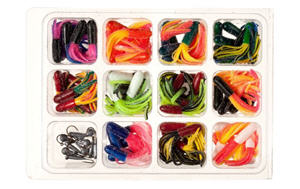
Kit
Two-inch tube jigs like Bass Pro Shops Tube Head Pro Jigheads are another great crappie bait beneath floats. They spiral instead of plummeting on the drop and drive crappie wild. Be warned though: A tube's downward arc can spell hang-ups around gnarly wood and debris. When fishing thick cover, use a regular jig instead because its straight drop is more conducive to snag-heavy spelunking.
Tip: Crappie, bluegill and bass all want color. You'll want to have the Bass Pro Shops 76-Piece Tutti Frutti Tube Kit in our fishing assortment.
Tied jigs have their advantages too. Beneath a float their fibers come alive, copying the micro movements of a nymph or the nervous twitches of a minnow. These subtitles frequently seduce strikes from on-looking crappie.
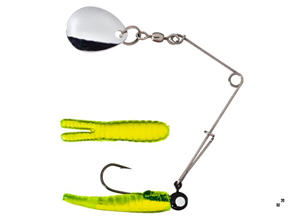
A noteworthy variation on this set-up is replacing the jig with a small blade bait like the Johnson Original Beetle Spin between 1/16- to 1/4-ounces. This upsize offering's a slab seeker. You can toss this rig a country mile and then work it into the zone you want to fish. Twitching your rod causes the bait to lift and send out vibrations and flash. Be sure to add plenty of pauses to allow fish to get in a good attack.
Tip: Crappie Fishing During Spring Spawn
Crappie Hardbaits and Jigging Tricks
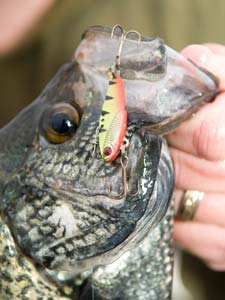
include minnows and insects.
Horizontal presentations are also handy in spring. They're excellent for working canal rock walls; over the tops of weeds or along their edges; and casting a shoreline. Floating or suspending minnowbaits and small cranks are great choices when fished on a stop-and-go retrieve. Counting down hair, grub and minnow jigs and working them on a straight or raise-and-drop presentation is another option to cover water. Be sure to maintain contact with the bait at all times as crappie often strike during the drop. Tiny topwater baits will also catch crappie, with dusk being particularly productive.
Fishing the Two-Step Cover Attack
Before moving in on a prime piece of cover, like a laydown, my first attack is to work the outer area. Keeping my distance, I'll pepper the periphery with long casts. When crappie are concentrated on cover, fish will sometimes hold on the edges so it pays to first work the outside areas. After I've exhausted this tactic, I'll move in to the heart of the cover and dissect it using a float and jig. This practice avoids the pitfall of passing over fish en route to the best-looking spot on a piece of cover.
A Word on Fishing Rods
A light-powered fishing rod and a fishing reel spooled with 4-pound-test fishing line is a great option for the above mentioned baits. Many hard-core panfish anglers also prefer the control and precision of telescopic and bamboo poles for dunking thick cover like bullrushes, laydowns and weeds. Available in a range of lengths (9 to 20 feet) these sticks let you drop baits into openings while keeping a safe distance to avoid spooking fish.
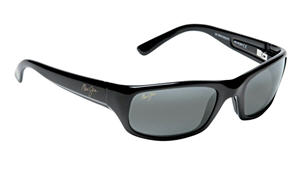
Sunglasses
The initial weeks of spring crappie fishing can be fantastic. To boost your catches, position yourself on the prime real-estate of the Three Cs and focus on woody and weedy cover. Give early-season crappie fishing a go this season. It's tough to beat the fun of landing slabs in the warm spring sunshine.
Tip: Polarized fishing sunglasses will enhance your ability to see fish and promising cover. Opt for lenses with impact protection as papermouths live up to their name and occasionally come unbuttoned, which can quickly turn a lure into a dangerous projectile
- 61900 views

